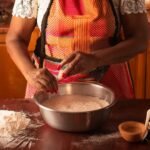Introduction
Bread is a staple food in many cultures around the world, and for good reason. Not only is it delicious and versatile, but it also provides essential nutrients that are important for children’s growth and development. In recent years, there has been a growing interest in creating bread recipes specifically tailored to children, with an emphasis on making them both fun and nutritious. In this essay, we will explore the importance of bread in children’s diets, discuss the nutritional benefits of different types of bread, and provide some fun and creative bread recipes that are sure to delight even the pickiest eaters.
The Importance of Bread in Children’s Diets
Bread is often referred to as the “staff of life,” and for good reason. It is a rich source of carbohydrates, which are the body’s primary source of energy. For children, who are constantly growing and developing, carbohydrates are especially important for providing the energy they need to play, learn, and grow.
In addition to carbohydrates, bread also provides important nutrients such as fiber, vitamins, and minerals. Fiber is essential for maintaining a healthy digestive system and preventing constipation, which is a common problem in children. Vitamins and minerals found in bread, such as B vitamins, iron, and magnesium, are important for supporting overall health and development.
Furthermore, bread is often fortified with additional nutrients such as calcium and vitamin D, which are important for building strong bones and teeth. This makes bread an important part of a balanced diet for children, helping to ensure that they get the nutrients they need for optimal growth and development.
Curiosities About Bread in Children’s Diets: Exploring Nutritional Importance and Fun Recipes
Introduction
Bread, often referred to as the “staff of life,” holds a significant place in children’s diets worldwide. Beyond its role as a mere staple, bread offers a plethora of nutritional benefits crucial for the growth and development of young ones. This article delves into the curiosities surrounding bread in children’s diets, shedding light on its nutritional importance and presenting fun recipes tailored to appeal to their taste buds.
The Nutritional Significance of Bread for Children
Bread serves as a vital source of carbohydrates, supplying the energy necessary for children’s daily activities, including play and learning. Moreover, it contains essential nutrients like fiber, vitamins, and minerals, which are fundamental for maintaining optimal health.
Fiber Content
Fiber, abundant in whole grain bread, aids in digestion and prevents common childhood issues like constipation. By incorporating fiber-rich bread into their diets, children can maintain regular bowel movements and support a healthy digestive system.
Vitamins and Minerals
Bread contributes essential vitamins and minerals crucial for children’s growth and development. B vitamins, iron, and magnesium, found in bread, play integral roles in various bodily functions, ensuring overall well-being. Additionally, fortified breads provide calcium and vitamin D, promoting strong bones and teeth formation in growing children.
Exploring Bread Varieties for Children
While traditional white bread remains popular, exploring diverse bread varieties introduces children to a broader spectrum of nutrients and flavors. Whole grain bread, seeded bread, and bread enriched with fruits and vegetables offer unique nutritional profiles and tastes.
Whole Grain Bread
Whole grain bread, made from intact grains, retains the bran, germ, and endosperm, preserving its nutritional content. Compared to refined white bread, whole grain bread contains higher levels of fiber, vitamins, and minerals, making it a superior choice for children’s diets.
Seeded Bread
Bread enriched with seeds like flaxseeds, chia seeds, and sunflower seeds provides additional protein, healthy fats, and micronutrients. These seeds contribute to children’s overall nutrition while adding texture and flavor to the bread.
Bread with Fruits and Vegetables
Incorporating fruits and vegetables into bread recipes enhances their nutritional value and appeals to children’s palates. Ingredients like bananas, carrots, and zucchini not only add vitamins and minerals but also impart natural sweetness and moisture to the bread.
Fun and Nutritious Bread Recipes for Children
Engaging children in the kitchen fosters their creativity and encourages healthy eating habits. Here are some delightful bread recipes designed to captivate young taste buds:
1. Fruit and Nut Breakfast Bread
Ingredients:
- 2 cups whole wheat flour
- 1 teaspoon baking powder
- 1/2 teaspoon baking soda
- 1/4 teaspoon salt
- 1/2 cup honey or maple syrup
- 1/4 cup melted coconut oil
- 2 eggs
- 1 teaspoon vanilla extract
- 1 cup mashed bananas or applesauce
- 1/2 cup chopped nuts (such as walnuts or almonds)
- 1/2 cup dried fruit (such as raisins or cranberries)
Instructions:
- Preheat the oven to 350°F (175°C) and grease a loaf pan with coconut oil or line with parchment paper.
- In a large bowl, combine the whole wheat flour, baking powder, baking soda, and salt.
- In another bowl, whisk together the honey or maple syrup, melted coconut oil, eggs, and vanilla extract.
- Stir the wet ingredients into the dry ingredients until just combined.
- Fold in the mashed bananas or applesauce, chopped nuts, and dried fruit.
- Pour the batter into the prepared loaf pan and spread it evenly.
- Bake for 50-60 minutes, or until a toothpick inserted into the center comes out clean.
- Allow the bread to cool in the pan for 10 minutes before transferring it to a wire rack to cool completely.
- Slice and serve the fruit and nut breakfast bread with a spread of nut butter or cream cheese.
2. Veggie-packed Pizza Muffins
Ingredients:
- 1 1/2 cups whole wheat flour
- 1 teaspoon baking powder
- 1/2 teaspoon baking soda
- 1/4 teaspoon salt
- 1/2 cup plain Greek yogurt
- 1/4 cup milk (or dairy-free alternative)
- 1 egg
- 1/4 cup tomato sauce
- 1/2 cup shredded mozzarella cheese
- 1/2 cup chopped vegetables (such as bell peppers, mushrooms, and spinach)
- 1/4 cup grated Parmesan cheese
Instructions:
- Preheat the oven to 375°F (190°C) and grease a muffin tin with cooking spray or line with muffin liners.
- In a large bowl, whisk together the whole wheat flour, baking powder, baking soda, and salt.
- In another bowl, mix together the Greek yogurt, milk, and egg until smooth.
- Stir the wet ingredients into the dry ingredients until just combined.
- Fold in the tomato sauce, shredded mozzarella cheese, and chopped vegetables.
- Divide the batter evenly among the muffin cups, filling each about two-thirds full.
- Sprinkle the grated Parmesan cheese over the top of each muffin.
- Bake for 18-20 minutes, or until golden brown and a toothpick inserted into the center comes out clean.
- Allow the pizza muffins to cool in the tin for 5 minutes before transferring them to a wire rack to cool completely.
- Serve the veggie-packed pizza muffins warm or at room temperature as a delicious snack or lunch option.
3. Peanut Butter and Banana Roll-ups
Ingredients:
- 2 slices whole wheat bread
- 2 tablespoons peanut butter (or almond butter)
- 1 banana, peeled
- 1 tablespoon honey or maple syrup
- 1/4 teaspoon cinnamon
Instructions:
- Using a rolling pin, flatten the slices of bread until they are thin and pliable.
- Spread one tablespoon of peanut butter evenly over each slice of bread.
- Place a whole banana at one end of each slice of bread.
- Drizzle the bananas with honey or maple syrup and sprinkle with cinnamon.
- Roll up the bread tightly around the banana, pressing gently to seal the edges.
- Using a sharp knife, slice each roll-up into bite-sized pieces.
- Serve the peanut butter and banana roll-ups as a fun and nutritious snack or lunch option.
Bread holds a special place in children’s diets, providing essential nutrients and endless opportunities for culinary creativity. By exploring diverse bread varieties and incorporating fun and nutritious recipes into their meals, parents can nurture their children’s health and instill lifelong habits of balanced eating. Let’s embrace the wonders of bread in children’s diets, ensuring that every bite is both delicious and nourishing.
Nutritional Benefits of Different Types of Bread
Not all bread is created equal when it comes to nutrition. While white bread may be delicious, it is often made from refined flour, which has been stripped of many of its nutrients during processing. In contrast, whole grain bread is made from whole grains, which retain all of their natural nutrients, including fiber, vitamins, and minerals.
Whole grain bread is a much healthier option for children, as it provides more nutrients and fiber than white bread. Studies have shown that children who eat whole grain bread have lower rates of obesity, heart disease, and type 2 diabetes compared to those who consume white bread.
In addition to whole grain bread, there are also many other types of bread that can be beneficial for children’s health. For example, bread made with seeds and nuts provides additional protein and healthy fats, which are important for supporting growth and development. Likewise, bread made with fruits and vegetables can provide important vitamins and minerals that may be lacking in other parts of children’s diets.
Fun and Nutritious Bread Recipes for Children
Now that we’ve discussed the importance of bread in children’s diets and the nutritional benefits of different types of bread, let’s explore some fun and creative bread recipes that are sure to appeal to children of all ages.
1. Banana Bread Muffins
Ingredients:
- 2 ripe bananas, mashed
- 1/4 cup honey or maple syrup
- 1/4 cup melted coconut oil
- 1 egg
- 1 teaspoon vanilla extract
- 1 cup whole wheat flour
- 1 teaspoon baking soda
- 1/2 teaspoon salt
- Optional: chocolate chips, nuts, or dried fruit for added flavor
Instructions:
- Preheat your oven to 350°F (175°C) and grease a muffin tin with coconut oil or line with muffin liners.
- In a large bowl, mix together the mashed bananas, honey or maple syrup, melted coconut oil, egg, and vanilla extract until well combined.
- In a separate bowl, whisk together the whole wheat flour, baking soda, and salt.
- Gradually add the dry ingredients to the wet ingredients, stirring until just combined.
- If desired, fold in chocolate chips, nuts, or dried fruit.
- Divide the batter evenly among the muffin cups.
- Bake for 20-25 minutes, or until a toothpick inserted into the center of a muffin comes out clean.
- Allow the muffins to cool in the tin for 5 minutes before transferring to a wire rack to cool completely.
2. Veggie Pizza Scrolls
Ingredients:
- 2 cups whole wheat flour
- 1 tablespoon baking powder
- 1/2 teaspoon salt
- 1 cup plain Greek yogurt
- 1/2 cup marinara sauce
- 1 cup shredded mozzarella cheese
- Assorted chopped vegetables (such as bell peppers, cherry tomatoes, and spinach)
Instructions:
- Preheat your oven to 375°F (190°C) and line a baking sheet with parchment paper.
- In a large bowl, whisk together the whole wheat flour, baking powder, and salt.
- Gradually add the Greek yogurt to the dry ingredients, stirring until a dough forms.
- Turn the dough out onto a lightly floured surface and knead for 1-2 minutes, until smooth.
- Roll the dough into a rectangle approximately 1/4 inch thick.
- Spread the marinara sauce evenly over the dough, leaving a small border around the edges.
- Sprinkle the shredded mozzarella cheese over the marinara sauce, then top with the chopped vegetables.
- Starting from one long edge, tightly roll the dough into a log.
- Use a sharp knife to slice the log into 1-inch thick scrolls.
- Place the scrolls on the prepared baking sheet and bake for 20-25 minutes, or until golden brown and cooked through.
- Serve warm with additional marinara sauce for dipping.
3. Cheesy Spinach and Mushroom Quesadillas
Ingredients:
- 4 whole wheat tortillas
- 1 cup shredded cheddar cheese
- 1 cup chopped spinach
- 1 cup sliced mushrooms
- 1/2 teaspoon garlic powder
- 1/2 teaspoon onion powder
- Salt and pepper to taste
- Optional: salsa or guacamole for dipping
Instructions:
- Heat a large skillet over medium heat and lightly coat with cooking spray.
- Place one tortilla in the skillet and sprinkle half of the shredded cheddar cheese evenly over the surface.
- Top the cheese with half of the chopped spinach and half of the sliced mushrooms.
- Sprinkle with garlic powder, onion powder, salt, and pepper.
- Place another tortilla on top and press down gently to adhere.
- Cook for 2-3 minutes, or until the bottom tortilla is golden brown and crispy.
- Carefully flip the quesadilla and cook for an additional 2-3 minutes on the other side, until golden brown and crispy.
- Remove from the skillet and repeat with the remaining ingredients to make a second quesadilla.
- Allow the quesadillas to cool slightly before slicing into wedges.
- Serve warm with salsa or guacamole for dipping.
Conclusion
In conclusion, bread is an important part of children’s diets, providing essential nutrients such as carbohydrates, fiber, vitamins, and minerals. By choosing whole grain and nutrient-rich bread options, parents can ensure that their children get the nutrients they need for optimal growth and development. Additionally, by getting creative in the kitchen and experimenting with fun and nutritious bread recipes, parents can make mealtime enjoyable for the whole family. From banana bread muffins to veggie pizza scrolls to cheesy spinach and mushroom quesadillas, there are endless possibilities when it comes to creating delicious and nutritious bread-based meals for children. So why not get started today and see what delicious creations you can come up with? Your little ones will thank you for it!
References
- Harvard T.H. Chan School of Public Health. (2021). The Nutrition Source – Carbohydrates. Retrieved from https://www.hsph.harvard.edu/nutritionsource/carbohydrates/.
- Mayo Clinic. (2021). Whole grains: Hearty options for a healthy diet. Retrieved from https://www.mayoclinic.org/healthy-lifestyle/nutrition-and-healthy-eating/in-depth/whole-grains/art-20047826.
- American Heart Association. (2020). Whole Grains and Fiber. Retrieved from https://www.heart.org/en/healthy-living/healthy-eating/eat-smart/nutrition-basics/whole-grains-and-fiber.
- National Institute of Diabetes and Digestive and Kidney Diseases. (2016). Healthy Eating for School-age Children. Retrieved from https://www.niddk.nih.gov/health-information/weight-management/healthy-eating-school-age-children.
- The Academy of Nutrition and Dietetics. (2022). Eating Right Isn’t Complicated – Bread Basics. Retrieved from https://www.eatright.org/food/nutrition/dietary-guidelines-and-myplate/eating-right-isnt-complicated-bread-basics.
Olá, sou Romero Bachman, fundador e autor principal do Curiositando. Minha jornada começou com a ideia de criar um espaço online dedicado a abordar as questões mais curiosas do nosso cotidiano e que podem impactar em nossas vidas.




